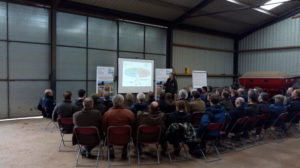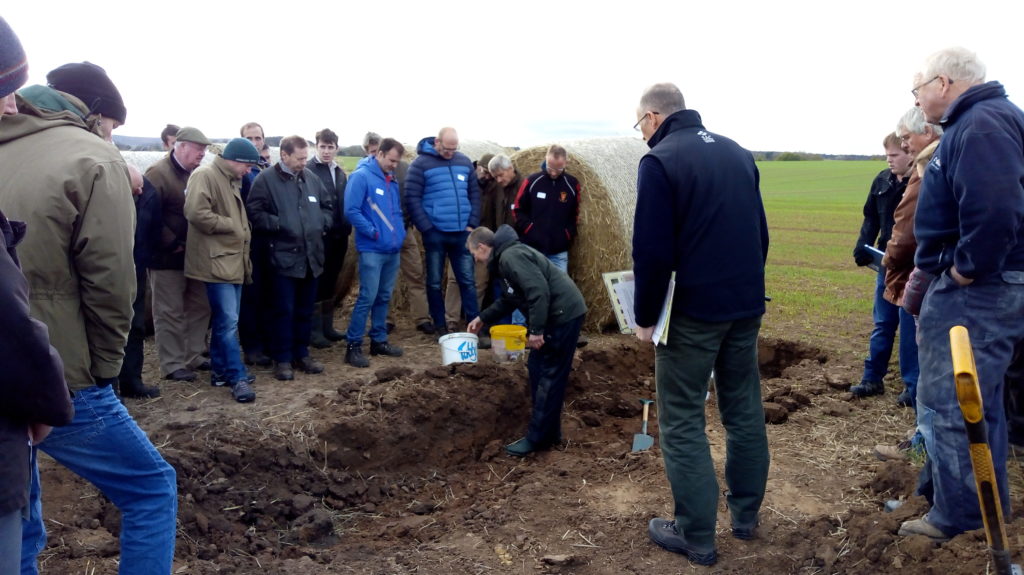East Lothian Soil & Nutrient Network: 1st meeting – event summary
24 October 2018This was the first of three meetings of the East Lothian Soil & Nutrient Network. It was held at the host farm, Bielgrange, with the kind permission of the Jeffery family.
Donald Dunbar, SAC Consulting, opened the meeting with an introduction into Bielgrange and the Soil & Nutrient Network programme. Bielgrange is one of 12 host farms from across Scotland, all taking a before and after  look at how improvements to farm productivity and profitability can be made through better soil and nutrient management. Donald’s presentation slides are available to read from this link.
look at how improvements to farm productivity and profitability can be made through better soil and nutrient management. Donald’s presentation slides are available to read from this link.
The group then heard from Professor Brian Griffiths about soil health and the key parameters to use to measure it. He highlighted the importance of interactions between chemical, physical and biological factors that can impact soil health and biodiversity. Following on from this, there was a short interactive session at an open soil pit to allow attendees to carry out a Visual Examination of Soil Structure (VESS) and worm counts, all with the help of a local agricultural consultants.
Following lunch, Jonathan Black, SAC Consulting, led a presentation on the results and benefits from GPS sampling for lime, highlighting the results from Bielgrange. You can read Jonathan’s presentation slides from this link.
Key Points
• The dry summer has benefited the structure of the clay loam soil at Bielgrange resulting in good autumn seedbeds. For others the dry conditions have allowed; more use of minimum tillage and remedial action to be to address structure issues
• A healthy soil is good chemical status, good soil biology (5 t/ha of soil life) and good physical structure
• Worms live for up to three years. Good numbers are >9 in a 20 x 20 mm block of soil
• Soil testing for sulphur identifies risk of crop deficiency but plant tissue analysis of nitrogen:sulphur ratio give the definitive answer of deficiency.
• Use crop yield and soil status information to calculate nutrient replace requirements. Higher crop yield = greater nutrients removed
• Correct pH is key to maintaining field performance. Using GPS at 4 samples per ha greatly improves the detection of areas of low pH and allows targeted lime applications to remove field variation
• Yield loss below pH 5.5 can be as much as 30% in wheat and 50% in barley
• Correcting each ha of soil below pH 5.5 will result in a wheat yield response up to 3 t/ha (based on 10 t/ha crop).Other than nitrogen, what other input can do that?
You can download information available at the meeting and other relevant material using the links below.
- Valuing Your Soils – Practical Guidance for Scottish Farmers
- This brochure includes useful information about Scotland's agricultural soils and practical advice outlining the upfront financial savings and business benefits of better soil management and the efficient use of resources. Action and problem-specific 'field-sheets' are designed for busy farmers with limited time for reading.
- Topics: Climate Change, Soils, Water Management and Crops and Soils
- Technical Note (TN656): Soil Information, Texture & Liming Recommendations
- • Web based access to information on your soils on your farm is described. • Soil texture classes of mineral soils are described and identified by hand texturing. • Liming recommendations for different soils and managements are tabulated.
- Topics: Soils
- Practical Guide – Optimising Inorganic Nitrogen
- This Practical Guide concentrates on how you can manage nutrient application and help reduce GHG emissions.
- Topics: Soils, Climate Change and Water Management
- Practical Guide – Optimising Organic Nitrogen
- This Practical Guide concentrates on how you can manage organic nitrogen to benefit the business and help reduce GHG emissions.
- Topics: Soils, Climate Change and Water Management
- Farming For A Better Climate: Practical Guide – Alleviating Soil Compaction
- This Practical Guide gives some ideas on how to alleviate soil compaction.
- Topics: Soils
- Farming For A Better Climate: Practical Guide – Field Drainage
- Topics: Soils and Water Management
- Farming For A Better Climate: Practical Guide – Improving Soil Quality
- This Practical Guide concentrates on how we can improve soil quality to help us to adapt to climate change.
- Topics: Soils
- Farming For A Better Climate: Practical Guide – Soil Management
- Topics: Soils
- Practical Guide: Nutrient budgeting I – The Benefits to your Business
- This practical guide looks at the benefits of creating and using a nutrient budget for your farm business.
- Topics: Climate Change
- Practical Guide: Nutrient Budgeting II – Getting Started
- This practical guide looks at what factors you need to consider when making a nutrient budget for your farm, fertiliser recommendations and how to get the most out of your nutrient budget.
- Topics: Climate Change
- Practical Guide: Soil sampling I – How to take a soil sample
- This practical guide details what is required to take a soil sample for analysis that is representative of the area sampled.
- Topics: Soils, Climate Change and Water Management
- Practical Guide: Soil sampling II – Benefits to your business
- This practical guide details how soil sampling can benefit businesses by increasing productivity and create efficiencies on fertiliser inputs through better nutrient planning.
- Topics: Soils, Climate Change and Water Management
Sign up to the FAS newsletter
Receive updates on news, events and publications from Scotland’s Farm Advisory Service

